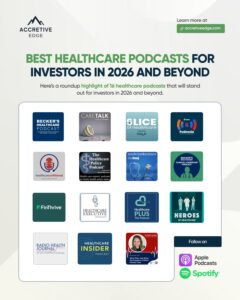The State of Healthcare Marketing in 2026
Healthcare marketing in 2025 is defined by higher competition, more informed buyers, and a clear shift toward measurable digital performance.
Traditional awareness campaigns are giving way to outcome-driven programs that connect marketing activity directly to booked revenue.
- Digital advertising now makes up roughly 72% of all media spend in healthcare and pharma, showing how strongly marketing budgets have shifted online.
- Spending continues to rise, with U.S. healthcare ad budgets growing about 3.8% annually through 2033 as teams invest in digital channels and AI-assisted personalization.
This move toward digital is reshaping how healthcare companies compete. Patients, clinicians, and procurement teams all expect tailored experiences, on-demand information, and consistent follow-up across channels.
Customer Acquisition Costs (CAC) and Lead Benchmarks
In healthcare, CAC varies widely depending on who the buyer is and how complex the sale becomes. Across most segments, though, costs continue to rise.
- According to WebFX, the average cost per lead in healthcare ranges from about $200 to $500, with most providers falling near the middle of that range.
- Typical benchmarks show $367 for B2C and $377 for B2B.
- Organic leads average around $320; paid digital leads about $400.
For early-stage digital health companies, CAC often runs higher because of limited brand trust, complex compliance reviews, and low conversion efficiency in early GTM stages.
In contrast, consumer-focused clinics and telehealth providers with simpler offerings could drive CAC down by emphasizing call conversions and referral programs.
Several factors push CAC upward in healthcare:
- Multiple stakeholders. Even small deals often involve legal, IT, and compliance approvals.
- Regulatory friction. Long procurement cycles and data security reviews delay conversion.
- Fragmented targeting. Marketing teams often chase too broad an audience, reducing qualified lead rates.
To keep CAC sustainable, high-performing teams are investing in better segmentation, multi-channel attribution, and content tailored to specific buyer roles.
Conversion Rate and Channel Performance
Conversion performance in healthcare depends heavily on the channel, the buyer journey, and the product’s level of complexity.
In 2026, the main challenge won’t just be getting leads, but converting them into appointments, demos, or contracts.
- Healthcare practice websites typically convert between 2% and 5% of visitors.
- Broader “health and wellness” landing pages show a median conversion rate of about 5.1%.
Phone and call conversions remain far stronger than online forms.
- Nearly 90% of healthcare appointments are scheduled by phone
- 15% to 25% of healthcare calls lead to booked appointments
This makes inbound calls one of the most valuable conversion channels.
Email continues to deliver dependable, low-cost performance:
- Open rates are between 34% and 44%
- Click-through rates between 1.7% and 4.6%
- The industry sees an average conversion rate of around 2.6%
- Returns remain high, generating about $42 in revenue for every $1 spent
Together, these data points highlight how conversion performance in healthcare relies on integrated, multi-channel systems.
Patients and buyers rarely complete their journey in one step; most research online, call for clarification, and only then commit.
A solid approach for most marketing teams is to track these touchpoints across web, phone, and CRM systems so that no lead falls through the cracks.
Sales Cycle and GTM Velocity
Healthcare’s commercial process is one of the longest and most complex among major industries. Even when marketing generates qualified demand, the time from first contact to closed revenue can stretch for months:
- The average healthcare sales cycle lasts between six and nine months.
- For enterprise software and high-compliance solutions, it can extend to twelve months or longer and involve 6-10 stakeholders across clinical, IT, compliance, and finance functions.
- Cycles are typically faster — three to six months — for consumer-facing telehealth, remote monitoring, and AI-driven diagnostics, where purchasing decisions are more direct and involve fewer institutional layers.
Long cycles aren’t just a sales challenge — they also affect marketing efficiency. Extended timelines drive up CAC and make attribution harder. Marketing and sales teams can’t operate in silos; they need full GTM alignment to maintain velocity.
Common causes of slow cycles include:
- Procurement and compliance reviews that add weeks or months.
- Proof-of-concept or pilot phases that delay full contracts by another three to six months.
- Buyer risk aversion, requiring extensive validation before commitment.
Organizations improving GTM velocity tend to share three traits: consistent account-based engagement, strong buyer education, and cross-functional coordination between marketing, sales, and product.
In healthcare, velocity is less about pushing deals faster and more about removing friction before it starts.
ROI and Marketing Efficiency
As healthcare marketing budgets continue shifting toward digital, teams face growing pressure to prove measurable returns. The central question is no longer about visibility, but how much revenue each marketing dollar creates.
Improving attribution and lead quality has shown clear payoffs:
- Healthcare organizations using call tracking and AI-driven attribution have reduced marketing costs by more than 20% and improved ROI by up to 400% within a year.
While those outcomes reflect upper-range performance, they highlight how tighter integration between marketing systems and CRM data directly improves efficiency.
What’s Shaping Healthcare Marketing Performance in 2026
Healthcare marketing in 2026 will be driven by technology adoption, evolving buyer behavior, and growing demands for speed and trust. Teams have to adapt to new expectations about how patients and buyers want to engage, and how quickly they expect a response.
AI plays a growing role, with about 68% of healthcare providers planning to use AI to improve lead generation and qualification.
Automation tools now help personalize outreach, qualify intent, and reduce delays in follow-up — cutting lead response times from days to minutes.
Search visibility remains critical:
- There are more than 70,000 health-related Google searches every minute, making discoverability a baseline requirement.
- Roughly 84% of patients read online reviews before selecting a provider, and most prefer those with at least four-star ratings.
Being visible isn’t enough — buyers now prioritize credibility and trust.
Responsiveness has also become a conversion driver
- 91% of patients expect a reply within 4 to 24 hours after reaching out
- Slow responses remain one of the top reasons leads fail to convert.
These shifts emphasize three performance priorities:
- Personalization at scale – tailoring outreach through data and automation.
- Proof of credibility – using reviews, case studies, and transparent communication to build trust.
- Omnichannel continuity – ensuring consistent experiences across web, phone, and sales handoffs.
Healthcare organizations that deliver on those priorities are already outperforming peers still focused on volume-based tactics.
Strategies to Improve CAC and Conversion (What The Data Suggests)
Industry data points to a clear pattern: improving healthcare marketing performance is less about spending more and more about removing friction. The best-performing organizations turn benchmarks into repeatable systems that shorten cycles, lift conversion rates, and lower CAC.
1. Narrow targeting through account-based marketing (ABM):
Enterprise health tech teams that build campaigns around named accounts and buyer groups — rather than broad personas — consistently see faster cycles and stronger close rates. Including clinical, IT, and financial stakeholders early in the process helps prevent rework and delays later.
2. Strengthen multi-touch engagement:
Healthcare buyers require multiple interactions before committing. Effective outreach now includes eight or more coordinated touchpoints across email, LinkedIn, webinars, and direct follow-ups. Automation helps maintain persistence without overwhelming prospects.
3. Improve web and landing page performance:
Even small technical and design improvements — clear calls to action, faster load times, and visible trust signals — can meaningfully raise conversion rates. Every additional second of page load time reduces conversion probability.
4. Use pilot programs to boost trust:
In long enterprise sales cycles, structured pilot programs give buyers a low-risk way to test value. Successful pilots often convert “interest” into measurable early-stage revenue.
5. Automate nurture and response:
Delayed follow-up remains a top cause of lost leads. AI-driven scheduling and automated nurture sequences could help teams respond within minutes, improving lead-to-close rates and aligning with patient response expectations.
6. Align marketing metrics with revenue operations:
High-growth healthcare companies unify CAC, conversion rate, pipeline velocity, and ROI in shared dashboards. This integration turns data into direction, helping teams act on what’s working instead of reacting after the fact.
Each of these tactics supports the same outcome: predictable, repeatable revenue growth. In 2026, the leaders will be those who measure early, adjust quickly, and align execution across every function.
Efficiency Defines Growth in Healthcare Marketing in 2026
The takeaway is simple: progress comes from reducing guesswork and tightening execution. Teams that build clear visibility from marketing to closed revenue are the ones that’d scale predictably.
If your GTM strategy isn’t converting, we work with healthcare and health tech teams to build and execute the systems that drive U.S. revenue — aligning strategy, sales channels, and execution so growth stops stalling and starts compounding. Get in touch today.






